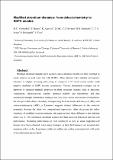Files in this item
Modified strontium titanates : from defect chemistry to SOFC anodes
Item metadata
| dc.contributor.author | Verbraeken, Maarten Christiaan | |
| dc.contributor.author | Ramos, T | |
| dc.contributor.author | Agersted, K | |
| dc.contributor.author | Ma, Q | |
| dc.contributor.author | Savaniu, Cristian Daniel | |
| dc.contributor.author | Sudireddy, B R | |
| dc.contributor.author | Irvine, John Thomas Sirr | |
| dc.contributor.author | Holtappels, Peter | |
| dc.contributor.author | Tietz, F | |
| dc.date.accessioned | 2015-11-26T00:12:04Z | |
| dc.date.available | 2015-11-26T00:12:04Z | |
| dc.date.issued | 2015 | |
| dc.identifier | 159849432 | |
| dc.identifier | 61702413-7bc2-4988-b786-eeae6c587407 | |
| dc.identifier | 000346079900040 | |
| dc.identifier | 84916608366 | |
| dc.identifier.citation | Verbraeken , M C , Ramos , T , Agersted , K , Ma , Q , Savaniu , C D , Sudireddy , B R , Irvine , J T S , Holtappels , P & Tietz , F 2015 , ' Modified strontium titanates : from defect chemistry to SOFC anodes ' , Royal Society of Chemistry Advances , vol. 5 , no. 2 , pp. 1168-1180 . https://doi.org/10.1039/c4ra09751c | en |
| dc.identifier.uri | https://hdl.handle.net/10023/7850 | |
| dc.description | The authors acknowledge funding from the Fuel Cells and Hydrogen Joint Undertaking under grant agreement no. 256730. | en |
| dc.description.abstract | Modified strontium titanates have received much attention recently for their potential as anode material in solid oxide fuel cells (SOFC). Their inherent redox stability and superior tolerance to sulphur poisoning and coking as compared to Ni based cermet anodes could improve durability of SOFC systems dramatically. Various substitution strategies can be deployed to optimise materials properties in these strontium titanates, such as electronic conductivity, electrocatalytic activity, chemical stability and sinterability, and thus mechanical strength. Substitution strategies not only cover choice and amount of substituent, but also perovskite defect chemistry, distinguishing between A-site deficiency (A1-xBO3) and cation-stoichiometry (ABO3+δ). Literature suggests distinct differences in the materials properties between the latter two compositional approaches. After discussing the defect chemistry of modified strontium titanates, this paper reviews three different A-site deficient donor (La, Y, Nb) substituted strontium titanates for their electrical behaviour and fuel cell performance. Promising performances in both electrolyte as well as anode supported cell designs have been obtained, when using hydrogen as fuel. Performances are retained after numerous redox cycles. Long term stability in sulphur and carbon containing fuels still needs to be explored in greater detail. | |
| dc.format.extent | 13 | |
| dc.format.extent | 2503799 | |
| dc.language.iso | eng | |
| dc.relation.ispartof | Royal Society of Chemistry Advances | en |
| dc.subject | QD Chemistry | en |
| dc.subject.lcc | QD | en |
| dc.title | Modified strontium titanates : from defect chemistry to SOFC anodes | en |
| dc.type | Journal item | en |
| dc.contributor.sponsor | European Commission | en |
| dc.contributor.sponsor | EPSRC | en |
| dc.contributor.institution | University of St Andrews. School of Chemistry | en |
| dc.contributor.institution | University of St Andrews. EaSTCHEM | en |
| dc.identifier.doi | https://doi.org/10.1039/c4ra09751c | |
| dc.description.status | Peer reviewed | en |
| dc.date.embargoedUntil | 2015-11-26 | |
| dc.identifier.grantnumber | 256730 256730 | en |
| dc.identifier.grantnumber | EP/K015540/1 | en |
This item appears in the following Collection(s)
Items in the St Andrews Research Repository are protected by copyright, with all rights reserved, unless otherwise indicated.

